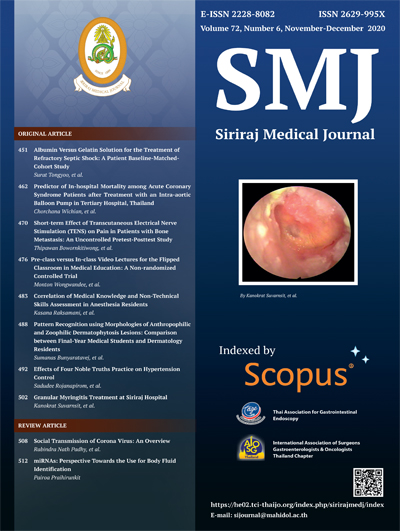Social Transmission of Corona Virus: An overview
DOI:
https://doi.org/10.33192/Smj.2020.69Keywords:
COVID-19, social distancing, social transmission, pandemicAbstract
Corona virus (COVID19) causes an infectious disease of the upper respiratory tract, with terminating illness of failure of lungs. Being a viral disease, no ensconced drug for control is known and it is picked up by a new host the man as droplets in air released by a patient. The virus has been detected in 215 countries and World Health Organization (WHO) declared as an epidemic and pandemic. The common structures of social contact critically determine the spread of the infection from a patient; in the dearth of vaccines, the control of the virus has been its prevention of spread through systematic ‘social distancing measures’. Furthermore, the use of cotton facemask in public places and while dealing with one has been the robust method of prevention of spread of the virus from sneezing or talking with anyone. It was seen from January to April 2020 counties followed social distancing procedures without touching; hand-shaking or hugging with any one had least number of COVID19 affected persons. Hand washing with soap-water frequently to ward off any viral contamination obtained from touches of fomite or furniture etc., is rigorously followed, city disinfection with bleaching water has been additional practice in societies to abate infection from spits from patients in the common spaces. Moreover, the described types of social distancing framework adopted by some countries without additional measures prevented super-infection of the virus in societies. Finally, the findings have important implications for the policymaking to be adopted globally as well as, individual-scale preventive methods.
References
2. Ferguson, NM, et al., (2020). “Impact of non-pharmaceutical interventions (npis) to reduce covid-19 mortality and healthcare demand,” London: Imperial College COVID-19 Response Team, March 16 (2020); 10.25561/77482.
3. World Health Organization (2020). “Global Surveillance for human infection with novel coronavirus (2019-nCoV)”. World Health Organization, 31 January 2020. Retrieved 08
4. World Health Organization (2020). Rational use of personal protective equipment for corona virus disease (COVID-19): interim guidance, 27 February 2020.
5. World Health Organization (2020). Novel Corona virus (2019-nCoV): situation report, 28 March 2020. Retrieved from: https://www.who.int/emergencies/diseases/novel-coronavirus-2019/situation-reports.
6. Kathleen, M, Stacy, APRN, RN, (2020). Isolation Precautions: Personal Protective Equipment. Isolation Precautions: Personal Protective Equipment. GN_08_2
7. Centers for Disease Control and Prevention (CDCP) (2020). www.cdc.gov.
8. World Health Organization (2020). www.who.int. 20 April 2020.
Downloads
Published
How to Cite
Issue
Section
License
Authors who publish with this journal agree to the following conditions:
Copyright Transfer
In submitting a manuscript, the authors acknowledge that the work will become the copyrighted property of Siriraj Medical Journal upon publication.
License
Articles are licensed under a Creative Commons Attribution-NonCommercial-NoDerivatives 4.0 International License (CC BY-NC-ND 4.0). This license allows for the sharing of the work for non-commercial purposes with proper attribution to the authors and the journal. However, it does not permit modifications or the creation of derivative works.
Sharing and Access
Authors are encouraged to share their article on their personal or institutional websites and through other non-commercial platforms. Doing so can increase readership and citations.















